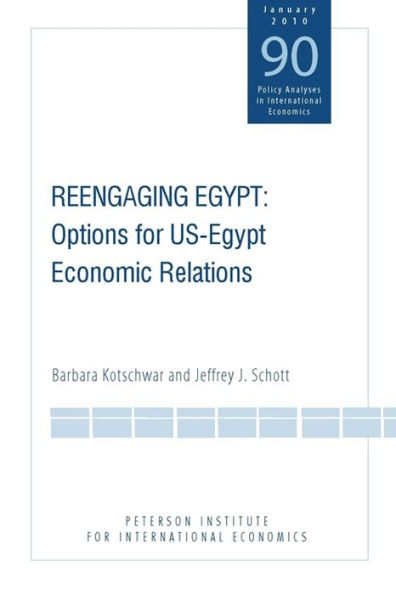
Reengaging Egypt: Options for US-Egypt Economic Relations
128
Reengaging Egypt: Options for US-Egypt Economic Relations
128eBook
Related collections and offers
Overview

Product Details
| ISBN-13: | 9780881325058 |
|---|---|
| Publisher: | Peterson Institute for International Economics |
| Publication date: | 10/15/2009 |
| Series: | Policy Analyses in International Economics |
| Sold by: | Barnes & Noble |
| Format: | eBook |
| Pages: | 128 |
| File size: | 4 MB |
About the Author
Barbara Kotschwar, former research fellow, was associated with the Peterson Institute for International Economics from 2007 to October 2015. Her research focuses on trade, investment, and regional integration. Recent projects include comparative analyses of Latin American experiences with free trade agreements, Chinese foreign direct investment (FDI) in Latin America, an assessment of Mexico's economy, and studies on commercial relations between the United States and Middle East and North Africa (MENA) partners.
Jeffrey J. Schott joined the Peterson Institute for International Economics in 1983 and is a senior fellow working on international trade policy and economic sanctions. During his tenure at the Institute, Schott was also a visiting lecturer at Princeton University (1994) and an adjunct professor at Georgetown University (1986–88). He was a senior associate at the Carnegie Endowment for International Peace (1982–83) and an official of the US Treasury Department (1974–82) in international trade and energy policy. During the Tokyo Round of multilateral trade negotiations, he was a member of the US delegation that negotiated the GATT Subsidies Code. Since January 2003, he has been a member of the Trade and Environment Policy Advisory Committee of the US government. He is also a member of the State Department's Advisory Committee on International Economic Policy.
Table of Contents
Preface ix
Acknowledgments xiii
1 Introduction 1
2 Current State of Trade and Investment Relations 9
Evolution of US-Egypt Trade Initiatives: From Aid to Trade? 10
Egypt's Market Reforms: Enhancing Access and Bolstering Competitiveness 23
Remaining Challenges: The Future Agenda 38
3 Moving Forward: Options to Enhance Economic Relations 45
Enhancing Market Access in Goods: Expanding the QIZ 46
Stimulating Services Trade through a US-Egypt Services Trade Agreement 58
Modernizing the Bilateral Investment Treaty 67
Cooperation on Trade Facilitation Measures 72
Cooperation to Enhance Egypt's Trade Capacity: Infrastructure, Education, and Beyond 82
4 Summing Up 97
Appendix A Comparison of US Bilateral Investment Treaties with Uruguay and Egypt 105
Appendix B Do Bilateral Investment Treaties Increase Foreign Direct Investment? 111
References 117
Timeline of Key Events in US-Egypt Economic Relations 123
Index 131
Tables
1.1 Selected indicators for countries in the Middle East and North Africa 4
2.1 US trade and investment with MENA countries, 2008 11
2.2 US and Egyptian trade relations with MENA countries 14
2.3 Top 25 US imports from Egypt entering under the GSP program in 2008 16
2.4 US imports from Egypt: QIZ and total imports, 2005-08 21
2.5 Top 20 US imports from Egypt, 2000-08 24
2.6 US exports to Egypt, 2000-08 28
2.7 Egypt's top export destinations, 2000-08 32
2.8 Egypt's top sources of imports, 2000-08 33
2.9 Doing Business rankings for MENA countries, 2009 39
2.10 A. T. Kearney Global Services Location Index, 2007 40
3.1 Top 20 developing-country US apparel suppliers: Labor costs andmarket access, 2008 48
3.2 Egypt's revealed comparative advantage (RCA) index by HS section, 1996-2007 52
3.3 Top 20 US imports from Egypt produced under qualifying industrial zones, 2005-08 56
3.4 US imports of men's or boys' trousers, bib and brace overalls, breeches and shorts of cotton, not knitted or crocheted, 2004-08 57
3.5 Reliability and availability of infrastructure services: Electricity 63
3.6 Reliability and availability of infrastructure services: Telecommunications and water 64
3.7 US direct investment position abroad (historical-cost basis), 2008 68
3.8 Greenfield investment in Egypt from the European Union and the United States, 2003-08 70
3.9 Logistics Performance Index (LPI), 2007 74
3.10 Customs constraints 76
3.11 Transparency indicators 81
3.12 Egypt's scores on MCC indicators, 2005-08 85
3.13 Millennium Challenge Compact countries and projects 87
3.14 Infrastructure indicators, 2009 89
3.15 Education indicators, 2009 92
3.16 Gender equity in education indicators, 2009 93
Figures
2.1 US exports to and imports from Egypt, 1998-2008 10
2.2 US economic assistance to Egypt, FY2000-FY2009 12
2.3 US imports from Egypt: Role of GSP and QIZs, 1989-2008 18
2.4 US textile and apparel imports from Egypt, 2000-08 22
2.5 Egypt: Foreign direct investment stock and flows, 2000-07 35
2.6 Egypt: Foreign direct investment flows in the petroleum versus nonpetroleum sectors, 2004-08 35
2.7 US foreign direct investment position in Egypt (historical-cost basis), 1994-2007 36
2.8 Egypt's trade as a percent of GDP, 1990-2007 37
2.9 Egypt: Annual GDP growth, 1990-2009 37
2.10 Inflation in Egypt, 1990-2009 42
3.1 US imports from Egypt, 2000-08 47
3.2 Intellectual property protection in MENA countries, 2009 79
Box
2.1 The qualifying industrial zones (QIZ) program: Jordan's experience 19
